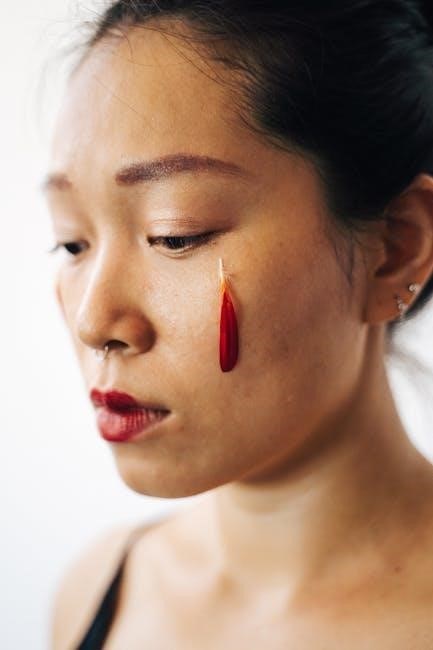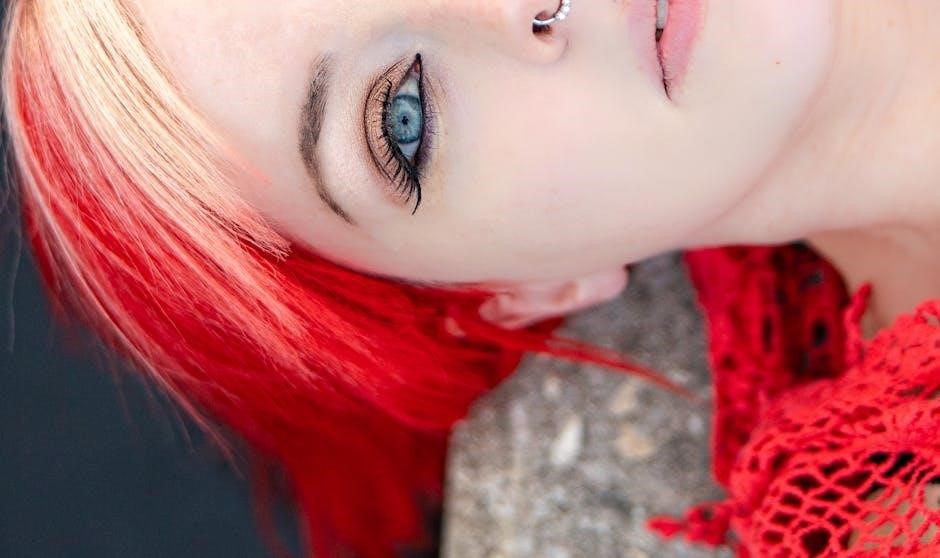Lip piercings are a popular form of body modification, offering versatility in styles and placements. They enhance personal aesthetics while requiring proper care for safe healing.
Types of Lip Piercings
Lip piercings come in various styles, from classic labret and Monroe to unique variations like snake bites and Madonna piercings, offering diverse options for personal expression.
2.1 Labret Piercing
A labret piercing is typically placed on the lower lip, often using a labret stud. It’s a popular choice due to its simplicity and versatility. Healing time ranges from 6 to 8 weeks with proper care. Jewelry options include studs with decorative ends, allowing for personalization. This piercing is favored for its subtle yet stylish appearance, making it a timeless favorite among those seeking a classic lip piercing look.
2.2 Monroe Piercing
The Monroe piercing is inspired by Marilyn Monroe’s iconic beauty mark. It involves a single stud placed on the upper lip, typically on the left side. This piercing is known for its classic, elegant look and is often used to enhance facial symmetry. Healing time averages 6 to 8 weeks, with proper aftercare essential for optimal results. Jewelry options include labret studs or flat discs, and the procedure is considered moderately painful due to the lip’s sensitive tissue.
2.3 Madonna Piercing
The Madonna piercing is a striking complement to the Monroe, featuring a stud on the upper lip’s right side. It mirrors the Monroe’s placement, creating a balanced aesthetic. This piercing is favored for its bold, symmetrical appeal and versatility in personal style. Healing typically takes 6 to 8 weeks, with similar aftercare practices as other lip piercings. Jewelry choices include labret studs or flat discs, and the pain level is comparable to the Monroe, due to the lip’s delicate tissue.
2.4 Snake Bites and Other Bite Variations
Snake bites involve two studs on the lower lip, creating a striking symmetrical look. Other bite variations like spider, vampire, and canine bites offer unique styles. These piercings are popular for their edgy appearance and can be customized with various jewelry. Healing time is typically 6-8 weeks, with proper aftercare essential to prevent complications. Pain levels are moderate, and jewelry options include labret studs or captive bead rings, allowing for personalization to suit individual aesthetics and preferences.
Jewelry Options for Lip Piercings
Popular jewelry options include captive bead rings, labret studs, and flat disc jewelry, each offering unique styles and customization to suit personal aesthetics and piercing types.
3.1 Captive Bead Rings
Captive bead rings are a popular choice for lip piercings, offering both style and comfort. The ring features a bead held securely in place by the tension of the jewelry, creating a sleek, minimalist look. These rings are easy to flip for oral piercings, making them a practical option. Available in various materials, captive bead rings can be customized with smooth, elegant beads or decorative options featuring gemstones, allowing for a personalized aesthetic that suits individual tastes and preferences.
3.2 Labret Studs
Labret studs are a classic choice for lip piercings, known for their simplicity and functionality. These studs feature a flat disc on the inside of the mouth and a decorative end visible outside, making them ideal for both subtle and bold looks. They are often preferred for their comfort and ease of use during the healing process. Available in various materials, labret studs can be customized with different gemstones or designs, offering versatility to match personal style preferences and enhance the piercing’s appearance effectively.
3.3 Flat Disc Jewelry
Flat disc jewelry is a popular choice for lip piercings, particularly for inner lip placements. These discs are designed to sit flush against the skin, minimizing visibility from the outside while maintaining a sleek, modern look inside the mouth. They are comfortable and discreet, making them ideal for those seeking a subtle aesthetic. Flat discs are often used in angel bites and other inner lip piercings, providing both functionality and style without compromising on comfort or appearance, making them a versatile option for various lip piercing types.

What to Expect During the Piercing Process
The piercing process involves preparing the area, marking the spot, and inserting the needle. A professional piercer uses sterile equipment to ensure safety and minimize discomfort.
4.1 Pain Levels Associated with Lip Piercings
Pain levels for lip piercings vary, with most describing it as mild to moderate discomfort. The lower lip tends to be less sensitive, while upper lip piercings may sting more due to nerve endings. Personal pain tolerance plays a significant role. Professional piercers ensure quick and precise procedures, minimizing pain. Topical anesthetics are rarely used but can be discussed for sensitive individuals. Overall, the process is brief, with discomfort subsiding quickly.

Lip Piercing Aftercare
Proper aftercare ensures fast healing. Clean with saline solution twice daily, rinse with salt water, and avoid harsh foods. Follow piercer’s tips for best results.
5.1 Cleaning and Hygiene Practices
Regular cleaning is crucial for healing. Use sterile saline solution to clean the piercing twice daily. Gently rinse with salt water, avoiding harsh chemicals. Keep hands clean before touching the piercing. Avoid submerging in water like baths or pools until healed. Maintain oral hygiene by rinsing with salt water after meals. Avoid spicy, acidic, or salty foods that may irritate the area. Proper hygiene prevents infections and promotes faster healing.
5.2 Saline Solution and Salt Water Rinses
Saline solution is a key cleaning agent for lip piercings. Mix 1/4 teaspoon of sea salt with 8 ounces of warm water and use it to rinse the piercing 2-3 times daily. This helps reduce swelling and promotes healing. Salt water rinses also aid in removing bacteria and debris. Use a clean cotton ball to gently wipe the area after rinsing. Avoid overly salty solutions, as they can cause irritation. Consistent use of saline solution supports a healthy recovery process.
Healing Time for Lip Piercings
Lip piercings typically heal within 6 to 10 weeks, but this varies based on piercing type, location, and aftercare practices. Proper care ensures faster recovery.
6.1 Average Healing Duration
The average healing duration for lip piercings ranges from 6 to 8 weeks, with most individuals experiencing full recovery within this timeframe. Healing time can vary slightly depending on the piercing’s location and individual aftercare practices. Proper hygiene and adherence to aftercare guidelines are crucial to ensure the piercing heals efficiently and without complications.
6.2 Factors Affecting Healing Time
Healing time for lip piercings can be influenced by several factors, including the piercing’s location, individual health, and aftercare practices. Piercings on the inner lip often heal faster due to the mouth’s natural regenerative properties, while outer lip piercings may take longer. Proper hygiene, a balanced diet, and avoiding irritants like spicy or acidic foods also play a role. Additionally, the type of jewelry used and overall oral health can impact the healing process. Professional aftercare advice is key to ensuring optimal recovery.
Cost of Lip Piercings
The cost of lip piercings varies based on location, jewelry selection, and piercer expertise. Prices range widely, but quality should never be compromised for cost.
7.1 Price Variations Based on Jewelry and Location
Prices for lip piercings vary significantly depending on the type of jewelry and location. Studios in urban areas often charge more due to higher overhead costs. Jewelry selection, such as captive bead rings or labret studs, also impacts the total cost. Basic piercings with standard jewelry may range from $40 to $80, while premium options with custom designs can exceed $150. Location and piercer expertise play a key role in pricing, ensuring quality and safety.

Potential Risks and Complications
Lip piercings carry risks like infection, swelling, and allergic reactions. Proper hygiene is crucial to avoid complications. Signs of infection include redness, discharge, and prolonged pain. Professional aftercare reduces these risks, ensuring a safe healing process and minimizing potential issues.
Infections can occur if lip piercings are not properly cared for. Signs include redness, swelling, discharge, and prolonged pain. To prevent infections, rinse the piercing with saline solution twice daily and avoid touching it unnecessarily. Avoiding spicy or acidic foods during healing can also reduce irritation. Following professional aftercare advice is crucial to minimize infection risks and promote a smooth recovery. Regular hygiene practices and using high-quality jewelry can further prevent complications.
Choosing the Right Piercer
8.1 Infection Signs and Prevention
Infections in lip piercings can cause redness, swelling, discharge, or increased pain. To prevent them, rinse with saline solution daily and avoid irritants like spicy foods. Following professional advice and maintaining hygiene is key. High-quality jewelry and proper aftercare reduce infection risks, ensuring a smooth healing process and minimizing complications.
9.1 Importance of Professional Piercing
Choosing a professional piercer ensures a safe and hygienic experience. They use sterile equipment and high-quality jewelry, minimizing infection risks. Proper technique and placement expertise are crucial for optimal healing and aesthetics. A reputable piercer provides personalized aftercare advice, addressing specific needs and reducing complications. Prioritizing professionalism guarantees a positive outcome and long-term satisfaction with your lip piercing.

Lifestyle Considerations Before Getting a Lip Piercing
Consider avoiding spicy, acidic, or salty foods and drinks during healing. Staying hydrated aids recovery, while avoiding harmful habits ensures optimal piercing health and comfort.
10.1 Dietary Restrictions During Healing
Proper nutrition is crucial for healing lip piercings. Avoid spicy, acidic, salty, or overly hot foods and drinks, as they can irritate the piercing. The Association of Professional Piercers recommends avoiding such items for the first two weeks. Opt for soft, non-irritating foods like yogurt or bananas. Staying hydrated is also essential, as it supports the body’s healing process. By adhering to these dietary guidelines, you can promote faster recovery and minimize discomfort during the healing phase.

Personal Style and Aesthetics
Lip piercings offer a customizable way to express personal style, allowing individuals to choose placements and jewelry that align with their unique aesthetic preferences.
Customizing your lip piercing allows for unique personalization. Choose from various jewelry styles like labret studs, captive bead rings, or flat discs. Experiment with gemstones, charms, or engravings to reflect your personality. Pair jewelry types with different placements, such as classic labret or bold bite variations, to create a look that suits your style. Consider color schemes and finishes to enhance your aesthetic, ensuring your piercing stands out as a true expression of individuality.
Common Mistakes to Avoid
11.1 Customizing Your Lip Piercing
Customizing your lip piercing involves choosing jewelry styles, such as labret studs or captive bead rings, and personalizing them with gemstones or engravings. Pairing jewelry with unique placements, like snake bites or Monroe piercings, enhances individuality. Consider color schemes and finishes to match your style, ensuring your piercing reflects your personality and aesthetic preferences.
12.1 Avoiding Improper Aftercare Practices
Improper aftercare can lead to infections or prolonged healing. Avoid using harsh chemicals, sharing jewelry, or touching the piercing unnecessarily. Refrain from using unsterile water for cleaning and never submerge the piercing in unhygienic environments. Avoid tight clothing that may irritate the area and skip oral piercings if you smoke heavily. Proper aftercare is crucial for a smooth recovery, so always follow your piercer’s guidelines and maintain good hygiene practices to prevent complications.
Lip piercings are a vibrant way to express personal style and confidence. With proper care and attention, they can be a stunning addition to your aesthetic. Remember, choosing a professional piercer and adhering to aftercare guidelines is crucial for a safe and successful experience. By understanding the types, risks, and responsibilities, you can enjoy your piercing while maintaining good health and unique self-expression.
